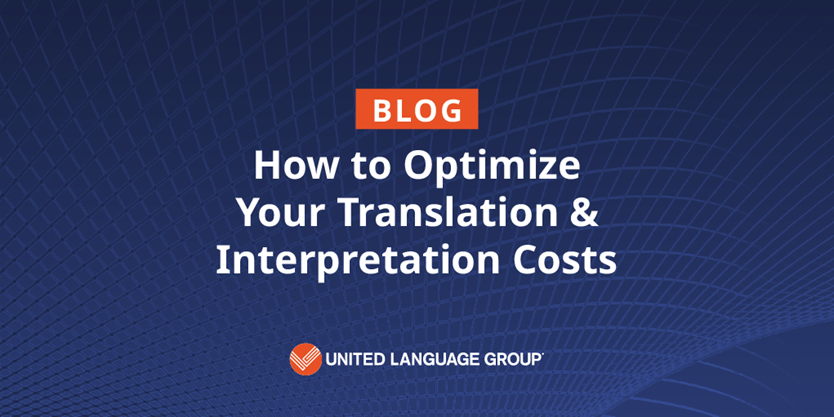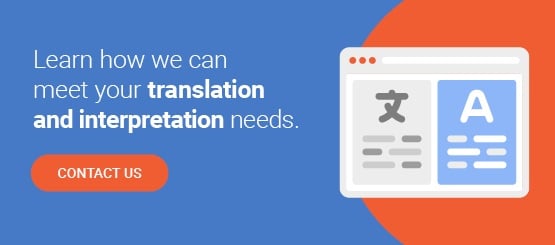Is your company getting the maximum value for the money you spend on translation and interpretation costs?
Developing a strong language access program is the key to supporting a multilingual, diverse customer base as well as achieving international business success. These services help businesses in all types of industries communicate internally, forge new partnerships, provide better customer service, and gain a competitive edge in a global market.
Yet, as a company grows, its language solutions provider (LSP) vendor list and associated spend can become increasingly complex to manage and maintain. Translation and interpretation services that are spread across many internal departments can introduce inefficiencies and redundancies.
The top challenge is to plan for the translation and interpretation costs and services your organization needs without deviating from your translation budget or compromising on quality. Planning ahead is key to managing translation and interpretation costs and maximizing value.
Here are six tips from our experts to help you avoid common pitfalls and reap the benefits of comprehensive, cost-effective translation and interpretation services even as your linguistic demographics shift.
1. Avoid Free Translation Solutions
There are numerous “free” translation tools and apps out there. But for businesses, they carry heavy hidden costs. As they say, “You get what you pay for.”
These free tools often come with inherent risks. For example, how will you verify accuracy, and what is the cost to your business of providing inaccurate translations? Free public translation solutions fail when it comes to linguistic and cultural nuance, and they don’t perform well when presented with industry-specific terminology.
Data security is also a major concern. When you opt for one of these solutions, your data may be stored and used to train the machine translation engine you used.
Working with an LSP that understands the specific nuances of your industry will serve you better in the long run. You’ll get accurate translations that are industry-specific and culturally relevant. You’ll avoid the pricey risks involved in “free” translations from public machine translation (MT) and artificial intelligence (AI) websites.
2. Identify Cross-departmental Needs
Your organization’s translation and interpretation solutions likely have to cover the needs of multiple internal departments. When you’re working on annual budgeting, answer the following questions to help guide your efforts:
- What translation and interpretation solutions does each specific department rely on?
- Which language translations are most often requested by customers?
- How frequently do customers request translation or interpretation?
- Do you require the assistance of linguists with specific industry knowledge?
If each department is responsible for cobbling solutions on their own as the need arises, you’ll spend more in the long run. It’s also possible that multiple departments are translating the same things in silos. Determine your needs at the organizational level, and then find one LSP who can meet them efficiently.
3. Centralize Your Localization Efforts
We often speak to organizations with many departments who work with multiple LSPs to translate the same documents. This duplication is a sure-fire way to drive up costs and create unnecessary inefficiencies.
There is a better way: centralize your translations and interpretations with one provider who will have visibility of all the translations being requested, be able to introduce efficiencies across departments, and eliminate redundant efforts.
4. Use Translation Memory Technology
Translation memories are databases that store approved translations of previously translated phrases.
This solution has a number of benefits:
- It eliminates redundancy,
- Establishes cohesive branding, and
- Creates a catalog of meaningful and iterative translations.
With TM software, you’re no longer translating from scratch, and your linguists have a better understanding of your brand voice and preferences.
Deploying this technology does take time, as the software “learns” your company’s unique guidelines, term bases, and glossaries. Teams who implement this type of translation product should schedule a period of integration into their timelines. It’s well worth the wait.
When translation memories are incorporated into a comprehensive translation management system like ULG’s Octave, additional efficiencies are unlocked.
5. Consider AI Translation and Interpretation Options
AI translation is a potential solution to maximize your translation budget, but it must be deployed strategically. As we mentioned above, free AI translation solutions like ChatGPT or the free public version of Google Translate are not secure and prone to various types of errors and biases. Also, not all content is suitable for AI translation. For example, marketing and creative copy require a level of cultural expertise that AI models don’t yet possess.
To get the benefits of AI without the risks, it’s important to understand what these tools are capable of, decide where they fit in your translation program, and design workflows that give you the advantages of AI while still ensuring quality and security. For critical content, AI translation combined with post-editing by expert human linguists may be a suitable solution that offers the best of both worlds.
Our AI Translation Pilot is a risk-free way to see if AI translation is right for your business and determine the best way to deploy it.
For interpretation. AI can’t replace qualified interpreters, but it can enhance IVR workflows, improving efficiency and customer satisfaction through enhanced self-service.
6. Stick to a Defined Translation Timeline
Did you know that rush translation fees can result in a more than 50 percent increase in translation costs? Avoid these fees by setting strict deadlines internally, as well as with your LSP.
Plan ahead, and consider the following:
- Are there regulatory deadlines to keep in mind?
- How many languages will you need translations for?
- When do you need the translations completed by?
- Have you established an efficient workflow to make sure your project stays on track?
This way, you manage your projects cost-effectively without going over your budget due to last-minute translation needs.
Maximize Your Translation and Interpretation Budget with a Trusted Partner
By using one trusted partner for all of your language solutions needs, you will get the most value from your translation costs. As a bonus, translation, interpretation and localization projects can be handled more efficiently as your language solutions partner learns more about your business and your brand.
Our team provides language solutions for businesses in a number of industries, and we’re ready to help you with superior project management, the latest technologies, and a network of skilled professionals to handle all of your language needs. Connect with our experts today to see how we can help maximize your translation and interpretation budget.


